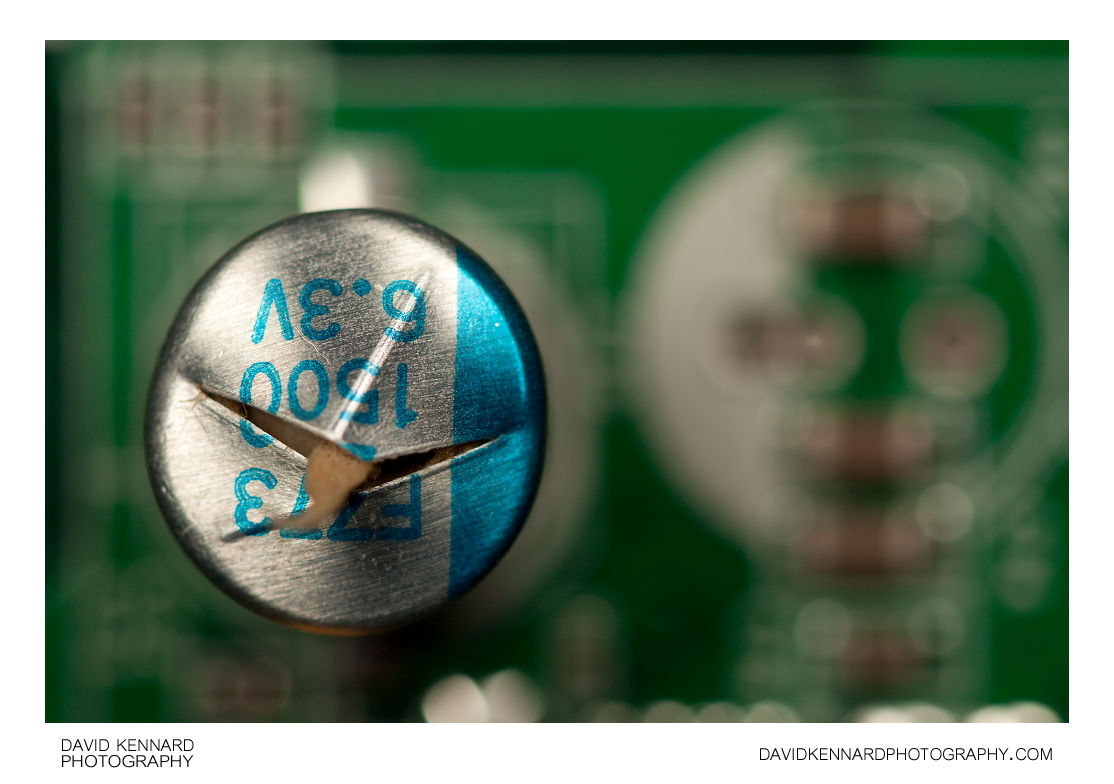Blown Capacitor

Description
- Title:
- Blown Capacitor
- Caption / Description:
-
A blown capacitor on a computer graphics card. The electrolytic capacitors used in computer equipment will fail due to old age, but there was also a large batch of faulty capacitors produced from around 1999 until 2007.
From Wikipedia (http://en.wikipedia.org/wiki/Capacitor_plague):
When a faulty capacitor is charged, the water-based electrolyte becomes unstable and breaks down, producing hydrogen gas. Since these types of capacitors are sealed in an aluminium casing, the pressure builds up within the capacitor until either the flat metal top of the capacitor begins to bend, or the rubber sealing plug is pushed down.Eventually the pressure exceeds the strength of the metal casing and venting occurs, either by blowing out the rubber bottom of the capacitor, or bursting the scored metal vent on the top of the capacitor. When an electrolytic capacitor bursts, effects can range from a pop and a hissing noise to a small explosion. Venting is typically messy, and the corrosive electrolyte must be cleaned off the motherboard to prevent further damage.
- Tags / Keywords:
-
- PC
- Blown
- Capacitor
- Computer components
- Electronics
- Faulty
- Graphics card
- Video Card
Admin
- Date Original Photo Taken:
- Original File Name:
- _MG_5147.CR2
- Event:
- Rating:
- ☆
- Date this image added/last updated on website:
- Original File Dimensions:
- 4156px x 2770px
- File Type:
- JPEG
- Color Mode:
- RGB
- Original Image Color Profile:
- Adobe RGB (1998)
Location
- Location Created:
-
- Sublocation:
- City:
- Market Harborough
- Province/State:
- Leicestershire
- Country:
- United Kingdom
- World Region:
- Europe
- Geo-location:
Rights
- Copyright Status:
- Copyrighted
- Licensing Status:
- Rights Managed
- Available for Editorial Use:
- Yes
- Available for Commercial Use:
- Yes
- Copyright Notice:
- © 2010 Dave Kennard
Camera Data
- Date Digital Resource was created:
- Shutter speed:
- 1⁄200 s
- Aperture:
- f/4
- Camera Model:
- Canon EOS 450D
- ISO:
- 100
- Exposure Compensation:
- 0
- Focal Length:
- 100mm
- Focal Length (35mm equiv.):
- Metering Mode:
- Multi-segment
- Flash:
- On, Fired
- Exposure Mode:
- Manual
- White Balance:
- Manual
- Light Source:
- Exposure Program:
- Manual
Additional shooting metadata
- Lens:
- Canon EF 100mm F2.8 Macro USM
- Filters used:
- Additional Optics used:
- Setup:
- Handheld
Canon MT-24EX Macro Twin Flash with home-made concave diffusers
Post Processing
- Image Modified:
- Software used:
-
- Adobe Camera RAW
- Post Processing:
Straightened in ACR
